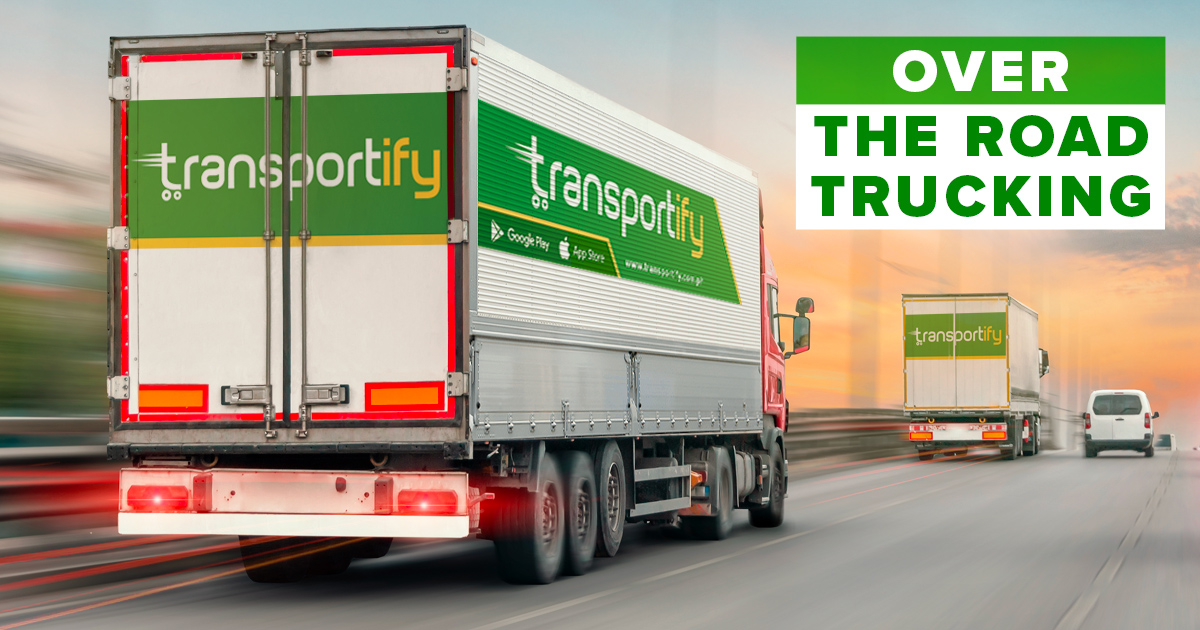
Over the road trucking is an essential aspect of logistics. By transporting goods and materials across the country, OTR truckers keep businesses running and products flowing to consumers. This article will look at OTR trucking, how it works, and the challenges OTR truckers face.
What Is OTR Trucking?
OTR trucking, or “over the road” trucking, is the movement of commercially shipped goods via truck or trailer rig. This term contrasts with intermodal shipping services, which use a combination of modalities and is most common in Philippine interisland transport.
Over the road trucking (OTR) is the haulage of freight over long distances, often across regions or national borders. OTR drivers are typically on the road for days, sleeping in either the truck’s cabin or at hotels/motels. In order to comply with driving regulations, many OTR drivers operate in shifts as part of a two-person team.
OTR driving is versatile; they transport anything from construction equipment to consumer products. Thanks to modern technology and advancements in the trucking industry, OTR driving is now safer and more efficient than ever before.
How the Term OTR Is Used Matters
The term “OTR” is frequently used in business, so make sure to pay attention to the context in it’s being used to avoid miscommunication. For example, “over the road transport” refers to using trucks without rail or maritime modalities when discussing shipping arrangements. Car dealerships use “OTR” to mean the price customers should expect to pay for a vehicle, including taxes, registration fees, and other expenses. This is different from how manufacturers typically use “OTR,” so it’s essential to be aware of the varied uses of “OTR” to avoid misunderstanding.
Types of OTR Trucking Routes
There are three trucking routes: over the road (OTR), regional, and local. OTR truckers haul freight long distances, often across state or country lines. Regional truckers make deliveries within a specific geographic area, while local truckers have a smaller delivery radius, for example, only within one city or town. Although all three types of drivers haul similar types of freight, there are some key differences between them.
OTR Trucking vs. Regional Trucking vs. Local Trucking
OTR Trucking
Over the road trucking is the most common type of long-haul trucking. OTR truckers spend weeks on the road, hauling freight across the country. In addition, OTR truckers are away from home for long periods, so they must take their trucks with them. This means that OTR trucks are typically larger and have more sleeping and storage space than regional or local trucks. Out of the three types of trucking, OTR truck drivers typically get paid the most; however, it also requires more experience and training.
Regional Trucking
Regional trucking is like OTR trucking because both involve carrying freight long distances. The key difference, however, is that regional truckers mainly operate within a specific region rather than driving across a region. As a result, regional trucking is an opportunity for those who want to get into the field but may need more experience or training for OTR. Usually, regional pay is lower than OTR; however, it’s a good place to start a career.
Local Trucking
Local trucking involves short distances, usually no more than 100 miles from the trucker’s home base. Out of the three types of trucking, local pays the least but doesn’t require as much experience. Local trucks can be smaller than others because they aren’t traveling long distances.
Challenges of OTR Trucking in the Philippines
In addition to the numerous scenarios to which “OTR” can be applied, other shipping challenges arise in the Philippines. The infrastructure in the Philippines is one of the main factors OTR Trucking has faced over the years. Due to the lack of urban development of roadways and passages and the poor mitigation of traffic management, the country needs to be better equipped to use this kind of transportation.
Due to its narrow roads and the improper regulation of issuance of franchises to tricycles and other public utility vehicles(PUV), the country is not as stable in facilitating “OTR” Trucking. This has led to dire traffic congestion and a lack of continuous support for trucking vehicles. The country, Metro Manila, has already imposed truck bans due to this traffic problem. Furthermore, the lagging delay and the poor development of roadways have also caused an increase in car accidents. Thus, the entire trucking industry of the nation and the Philippines’ economy has been greatly affected.
Intermodal and OTR Trucking
Although there have been some trucking bans across the country, the Philippines still allow light trucks in regard to the gross capacity weight they carry. This is about 4,500 kilograms or below, with at least six tires. On the other hand, there are exemptions to this rule for garbage, fuel, or other tracks carrying perishable goods.
However, there are intermodal in the Philippines to help alleviate the many problems associated with the challenges and truck bans in the country. For instance, islands such as Luzon, Visayas, and Mindanao have archipelagic structures with ports to facilitate ferrying cargo.
Transportify can assist in the express and affordable delivery services for you and your business nationwide. You can ensure your products will arrive safely and securely in a timely fashion.
 |
Pros and Cons of OTR Transportation
PROS
OTR trucking is a big part of the industry and has many proponents. However, one of the most important things OTR trucking does is provide reliability and consistency. Specially trained drivers do this trucking to handle long hauls across the country. They know the routes well and can deliver on time without fail. This is important for businesses that rely on Just-In-Time inventory methods, as delays can cause a production line to halt.
Additionally, new tracking methods have been developed that allow businesses to see where their product is at all times while in transit. This gives businesses greater peace of mind when it comes to their shipments. OTR trucking also offers more flexible schedules than other types of trucking. This can appeal to drivers who want more control over their time on the road. Finally, OTR trucking companies tend to have dedicated teams of drivers who work together regularly. This can create a sense of camaraderie and make the job more enjoyable. These factors make OTR trucking an attractive option for businesses and drivers.
CONS
OTR trucking can take a toll on both the driver and their family. Longer routes can mean more time away from home. In addition, OTR trucking can be physically demanding, and drivers may be required to work long hours with little rest. For all these reasons, it’s important to weigh the pros and cons of OTR trucking before deciding to become a driver.
SEE ALSO:
- Main Challenges for Logistics in the Philippines
- Importance of Technology in Transportation | Future of Logistics
- 5 Reasons Businesses Should Have Transport Management System
Is OTR Trucking Right for My Business?
The most common and well-known transportation method is by truck, but there might be better solutions for your business. One factor you must consider is your business’s location and destination. For example, if you’re sending cargo from Luzon to another region, it would be a requirement to use intermodal transport.
This is because the Philippines is a set of islands, so using trucking would involve ferrying the cargo from one island to another. Additionally, using intermodal freight transport would allow you to take advantage of different modes of transportation, such as rail or ship. This can often be cheaper but is usually a longer process than trucking alone.
This is another important transportation method to consider, as trucking services in the Philippines need more support from the government in terms of road infrastructure, as previously discussed. So, consider all the factors when deciding what transportation method to use for your business.
 | or |
Frequently Asked Questions:
Why is over the road trucking challenging?
🚚 Over the road trucking is challenging for several reasons. For example, drivers must spend lots of time driving, which can be tiring and dull. Bad weather can cause delays or shut down roads, potentially leaving drivers stranded. There are also potential dangers on the road, like traffic congestion, construction projects, and wildlife – all of which need to be considered when driving.
What are the three types of trucking routes?
🚚 The three main trucking routes are local, regional, and over the road. All three types of trucking routes require different levels of skill, experience, and attention to detail on the driver’s part to ensure the safe and timely delivery of goods and loads. Local routes are short from point A to point B within the same city or metropolitan area. Regional routes cover larger distances over multiple provinces. Over the road (OTR) trucking requires drivers to stay out on the open road for days at a time, often crossing islands to deliver loads.




 INSTANT QUOTE
INSTANT QUOTE

 Chat
Chat